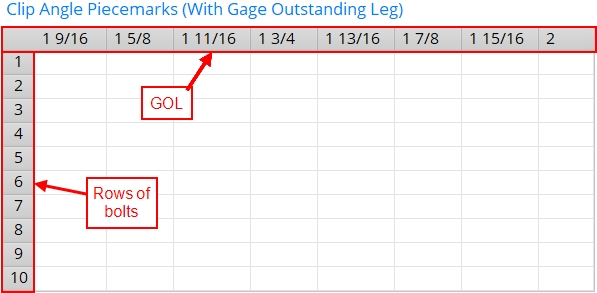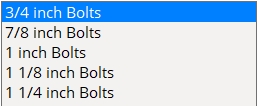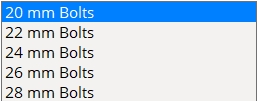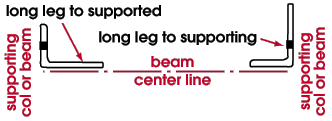Single Clip Angles Bolted OSL
- General Overview
- Tips and Tricks
- Related Tools

To specify this type of standard clip angle in the model :
| Each bolt diameter is a different clip angle configuration that must be set up separately. The list box shows Imperial sizes when the " Available Bolt Diameters " is 'Imperial '. Metric sizes are displayed when the " Available Bolt Diameters " is set to 'Metric '. If " Available Bolt Diameters " is set to 'Both ', the primary dimensioning "Units" will determine whether the list box shows Imperial or Metric bolt sizes. |
Standard angle size: The angle section size for the specific bolt diameter tab that has been selected. The angle must be listed in the local shape file.
To enter an angle section size: Either type in the section size that you want (e.g. ' L4x3 1/2x5/16 '), or press the "file cabinet" browse button (
) and choose an angle section from the list of angles in the local shape file .
Attach long leg to: Supported or Supporting . This applies when a " Standard angle size " with unequal legs has been entered (for example, the long leg for L3 1/2x3x5/16 angle material is the leg that is 3 1 /2 inches in length).
' Supported ' fastens the long leg of the angle to the web of the supported beam or the knife plate of the joist.
' Supporting ' fastens the long leg of the angle to the supporting beam or column.
Hole location on leg to supporting member: The distance to the center of the hole on the outstanding leg. Where this distance is measured from depends on the selection made to the " Hole location from... " field.
Measure hole location from web: Center or Face . This option sets the location that the distance set in the " Hole location... " is measured from.

If ' Center ' is selected, the " Hole location... " is measured from the supported beam's (or joist's) work line . That distance minus the web thickness of the beam (or joist knife plate) determines the gage on the outstanding leg of the clip angle.
If ' Face ' is selected, the " Hole location... " is measured from the face of the supported beam's web (or joist's knife plate) and that distance is the gage on the outstanding leg.
Clip Angle Piecemarks

When connection design creates a clip angle that exactly matches a clip angle defined on that table, SDS2 piecemarking assigns the piecemark that is entered for that clip angle. This ensures that standard piecemarks for clip angles come from a single setup source, regardless of your current Fabricator. This table is disabled (grayed out) when your current Fabricator is not the Master Fabricator .
Piecemarking: Standard piecemarks entered here are assigned to each single clip angles that is welded to the supported beam (or joist) according the GOL and number of rows of bolts designated on this table.
To make entries to this table: Click in the cell that corresponds to the GOL (gage on outstanding leg) and number of rows of bolts desired. Type in a clip angle standard piecemark of up to 61 characters.


|
|
OK (or the Enter key) closes this screen and applies the settings.
Cancel (or the Esc key) closes this screen without saving any changes.
Reset undoes all changes made to this screen since you first opened it. The screen remains open.
- Clip angle input specs (settings for clip angles)
- Setup of clip angle connections (index)
- Clip Angle Settings

 or
or



 or
or 







